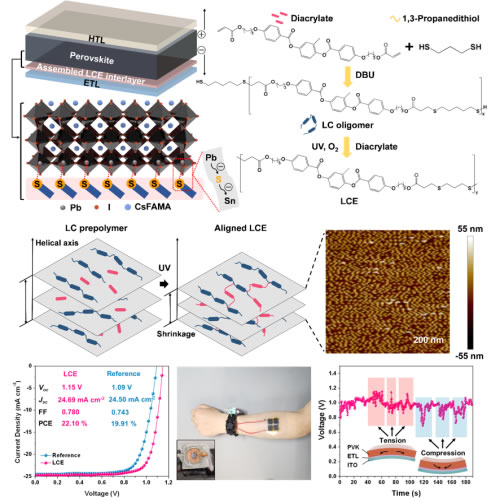Perovskite solar cells have drawn significant attention in the photovoltaic field thanks to their high energy conversion efficiency, cost-effectiveness, and low-temperature fabrication processes. These cells, particularly the flexible ones, offer not only impressive performance but also great flexibility, portability, and adaptability to curved surfaces, making them ideal candidates for integration with flexible electronics. This could pave the way for advancements in wearable tech and photovoltaic-integrated architectural solutions. However, these flexible solar cells face challenges related to reliability, especially when subjected to mechanical strain, which can lead to defects and performance degradation.
At the Key Laboratory of Green Printing, Institute of Chemistry, Chinese Academy of Sciences, led by Song Yanlin's research group, there has been remarkable progress in integrating flexible perovskite solar cells with wearable applications. Their studies, published in journals like *Adv. Mater.*, *Energy Environ. Sci.*, *Joule*, and others, have explored various methods to enhance the functionality and durability of these devices. By combining green nanoprinting techniques with innovative mechanical designs, they've laid the groundwork for practical applications in portable power supplies and wearable electronics.
Recently, the team introduced a novel approach using liquid crystal elastomers (LCEs) as molecular interlayers within the solar cells. This strategy aims to create well-ordered charge transport pathways, significantly boosting the stability and efficiency of the cells. When liquid crystal diacrylate monomers and liquid crystal oligomers with dithiol end groups are photopolymerized, the molecular order becomes permanently fixed. This organized structure provides enhanced surface energy and nucleation density, leading to more uniform perovskite film formation. Additionally, the orderly arrangement of liquid crystal units ensures efficient charge collection while minimizing carrier recombination at the SnOâ‚‚/perovskite interface. As a result, the rigid devices achieved an efficiency of 23.26%, while the flexible versions reached 22.10%.
The LCE interlayer also plays a crucial role in stabilizing the perovskite structure under prolonged illumination, preventing phase segregation and enhancing long-term operational stability (T80 > 1570 hours). Furthermore, the ordered molecular accumulation in the LCE interlayer helps relieve stress at the interface between the electron transport layer and the perovskite layer, reducing overall stress across the entire device structure. This contributes to maintaining the integrity of the device, even after 5,000 bending cycles, where the flexible device retained 86% of its initial efficiency.
The research extends beyond just improving cell performance. The team explored the integration of these robust solar cells into wearable tactile perception systems, creating a pain-sensing mechanism for virtual reality applications. This advancement represents a step forward in merging renewable energy technologies with next-generation wearable electronics.
These findings were published in *Nature Communications* in 2023 (Volume 14, Article 1204). The project received support from institutions such as the National Natural Science Foundation of China, the Ministry of Science and Technology, and the Beijing National Research Center for Molecular Sciences. Collaborative efforts with Jiangxi Normal University further enriched the research outcomes.

This image showcases a wearable perovskite solar cell enhanced by liquid crystal elastomer toughening, highlighting the potential of integrating advanced materials into everyday wearables.
DG Type High-Pressure Boiler Feed Pump
Main Feed Pump,Hydrogenation Feed Pump,Steam Driven Boiler Feed Pump
Shenyang pump products sales co., LTD , https://www.syipsc.com